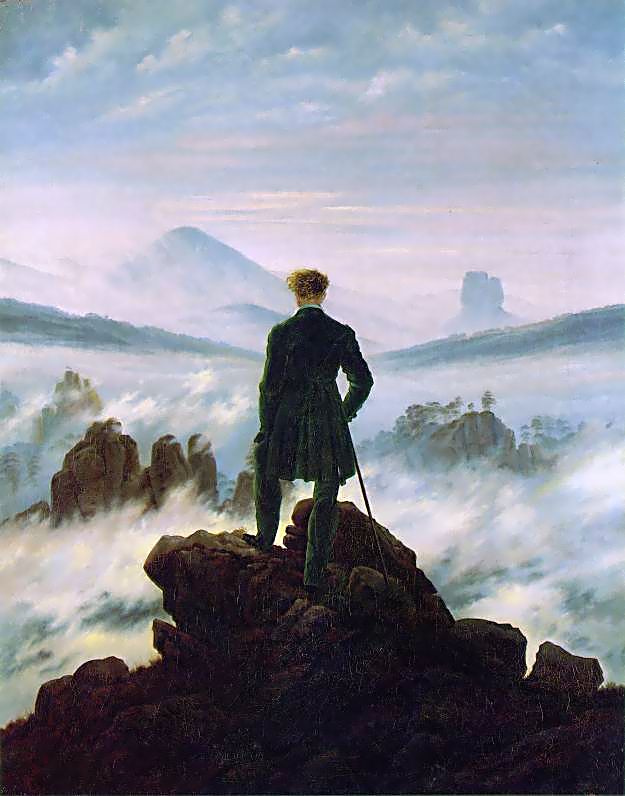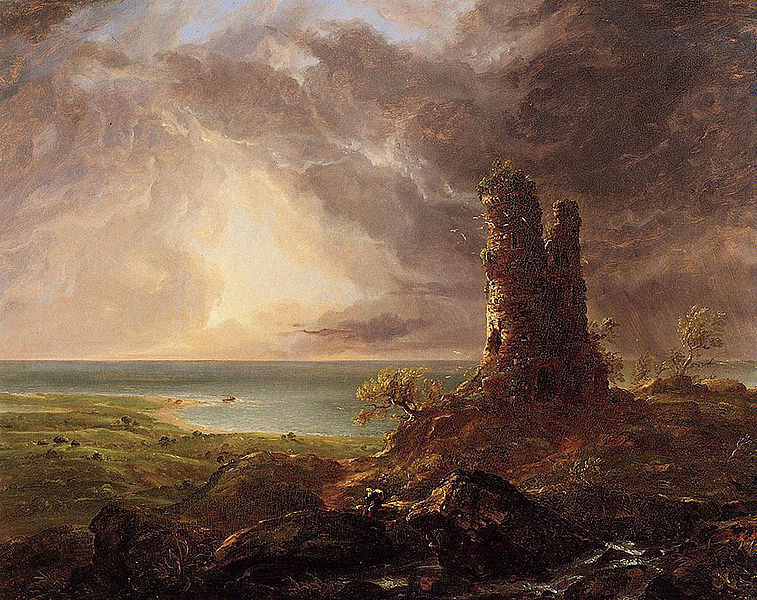
Romaticism and/or/vesus the Gothic
First, we need to distinguish between the Romance and Romanticism (both with capital "R" and both different from "romance" of your Valentine's Day weekend and "romantic" as in what your significant other did).
"Romance" refers (in the context we're using for discussion here) to "lengthy French or Spanish stories written in the 1500s and 1600s involving episodic encounters with supernatural or exciting events. The connotations were of wild adventures rather than romantic longing as in the modern meaning of romance" (http://web.cn.edu/kwheeler/lit_terms_R.html#romance_modern_anchor). Another definition explains "An extended fictional prose narrative about improbable events involving characters that are quite different from ordinary people. Knights on a quest for a magic sword and aided by characters like fairies and trolls would be examples of things found in romance fiction." (http://virtualsalt.com/litterms4.htm).
So many of the Gothic Novels we're reading (particularly Otranto) could be seen as Romances, dealing as they do with improbable characters with strange quests.
"Romanticism" refers to a particular movement in literature, NOT to those early tomes of the 15- and 1600s; Romanticism comes later, although it looks back to the Romance.
Now what about the Gothic Versus Romanticism?
"That Gothicism is closely related to Romanticism is perfectly clear, but it is easier to state the fact than to prove it tidily and convincingly. There is a persistent suspicion that Gothicism is a poor and probably illegitimate relation of Romanticism, and a consequent tendency to treat it that way. There are those, indeed, who would like to deny the relationship altogether." (Robert Hume, “Gothic Versus Romantic,” p.282)
Both the Gothic and the Romantic were transatlantic (or even global) movements, although so far we've focused on the British variety (as does most of the scholarship on both!).
Timelines (roughly):
Romanticism: 1770 through 1860: Begins (?) in Germany, spreads to England, hits France (1820s) and becomes popular in America through much of the nineteenth century. We're mostly talking about Romanticism in LITERATURE, but note that it's also appearing in music and visual arts, across all of these countries. Many point to the pubication of William Wordsworth's Lyrical Ballads in 1792 as the beginning of literary romanticism.
Gothic: Primary rise is usually considered 1765 (Walpole's Otranto) through 1820 (Maturin's Melmouth the Wanderer); it's primarily been studied as a British movement, but it's also a huge movement in America and on the Continent (France, Germany, etc.). I think it continues well beyond then, even to contemporary times.
Romanticism is sometimes characterized as the larger movement, of which the Gothic is a part, a subset, or variety. Other scholars see them as quite distinct, or even see the Gothic as the precursor that leads to the rise of Romanticism. Romanticism is probably the larger category in terms of number of authors and texts, and it's certainly priviledged by critics as the genre with greater aesthetic value. Gothic is often seen as the more popular genre; it's also identified more typically with women, while Romanticism is identified with men. Both of these factors lead to the further marginalizing of the Gothic compared to the Romantic.
So to get our grounding in the Gothic, let's talk about this term "Romanticism":
Romanticism was a transatlantic movement, including not just literature, but also painting and music. In my Romanticism-focused lecture, I like to use "the 5 I's" as a way to talk about the values in Romanticism. Romantics privledged the following categories:
We can see this in paintings, and in the kinds of characters (and real people) who were popular and idolized at the time.
Here's a quick version: "Romantic poets cultivated individualism, reverence for the natural world, idealism, physical and emotional passion, and an interest in the mystic and supernatural. Romantics set themselves in opposition to the order and rationality of classical and neoclassical artistic precepts to embrace freedom and revolution in their art and politics." (http://www.poets.org/poetsorg/text/brief-guide-romanticism).
You can see how these qualities, which can be seen as positive (and certainly were by the Romantics) can *also* be problematic. Individualism is actually not great for all individuals all the time. The natural world, while gorgeous and bountiful, can also be threatening and hostile. Idealism and passion can bring about amazing accomplishments; they can also damage and ruin people. The Gothic focuses more on those darker possibilities of Romanticism, and really dwells in the less pleasant -- and indeed, very real & threatening -- aspects of these Romantic ideals.
Many point to Germany as an early source of Romanticism in both literature and painting. For instance, this painting:

"Wanderer above the Sea of Fog" 1818
by Caspar David Friedrich (1774 - 1840), a German Romantic landscape painter.
What seems Romantic about this? What might be Gothic?
In both England and America, painters were diving into Romanticism. Thomas Cole is probably the most famous of the American Romantic painters:

"Romantic Landscape with Ruined Tower"* 1832-36
Thomas Cole (1801 - 1848) English-born American artist
What seems Romantic about the painting above? What seems Gothic?
*Important note: I've done some research and found out that Cole himself did not give it this title. In fact, it appears he didn't title the painting at all. According to the curator I contacted at the Albany Institute of Art (which owns the painting now), it is now titled "Ruined Tower (Mediterranean Coast Scene with Tower)."
Cole wrote an “Essay on American Scenery” that appeared in the Atlantic Monthly in which he compares American scenery with European, and remarks “You see no ruined tower to tell of outrage – no gorgeous temple to speak of ostentation.”
Cole painted several "ruined tower" canvases, but never named any of them "romantic." So we might think about where that title comes from, and how it changes our perception of the image, too!
Cole was a part of the Hudson River School, a group of Romantic painters who took the Hudson and New York state more generally as their subject matter. A key figure within this group was John Quidor, who was also a close personal friend of Washington Irving, who wrote in his stories about the very same geographic area. Quidor in turn, made paintings featuring scenes from Irving's stories:

"The Headless Horseman Pursuing Ichabod Crane." 1858
John Quidor (1901 - 1881) American painter (and friend of Washington Irving)
Landscape painting (as you can see above) was often particularly suffused with Romantic notions, and one element of the Romantic that is key here is THE SUBLIME: a aesthetic sense of greatness and vastness that creates in the viewer a feeling of fear or terror. In the U.S., places like Niagra Falls were prime spots for Romantic sightseers becaus of this belief in the beauty (and terror) of nature's power. Even more local sites in the U.S. proved to fit Romantic ideals of the sublime, as we see in this paining of Pawtucket Falls here in Lowell:

"Pawtucket Falls" 1833
Alvan Fisher (1792 - 1863), American Landscape painter.
So the Romantics were into the SUBLIME, but it also has a nice fit with the GOTHIC. While the sublime can be something transcendent -- something that transports you, it can also be something that induces terror, a prime element of the Gothic. So SUBLIME can sit -- sometimes uncomfortably -- both within Romanticism and the Gothic, depending on how it's used and how an individual experiences it.
MORE ON THE SUBLIME!
Another key text: Edmund Burke's Philosophical Enquiry into the Origin of our Ideas of the Sublime and Beautiful, published in 1757.
The term “sublime” is a key issue within the Gothic (and other literary genres, too). The term is a contested one, long-predating the Gothic, but the concept was very much in discussion at the time the Gothic was developing. Burke’s treatise is central to the emerging Gothic aesthetic. Burke’s central tenant was the separation of the beautiful from the sublime, which he established as incompatible categories, and, more importantly, that the sublime was caused by terror. Below are some excerpts from his essay (they're also on your handout).
TERROR:
No passion so effectually robs the mind of all its powers of acting and reasoning as fear. For fear being an apprehension of pain or death, it operates in a manner that resembles actual pain. Whatever therefore is terrible, with regard to sight, is sublime too, whether this cause of terror be endued with greatness of dimensions or not; for it is impossible to look on any thing as trifling, or contemptible, that may be dangerous. * * *
OBSCURITY:
To make any thing very terrible, obscurity seems in general to be necessary. When we know the full extent of any danger, when we can accustom our eyes to it, a great deal of the apprehension vanishes. Everyone will be sensible of this, who considers how greatly night adds to our dread, in all cases of danger, and how much the notions of ghosts and goblins, of which none can form clear ideas, affect minds, which give credit to the popular tales concerning such sorts of beings. Those despotic governments which are founded on the passions of men, and principally upon the passion of fear, keep their chief as much as may be from the public eye. The policy has been the same in many cases of religion. Almost all the heathen temples were dark. Even in the barbarous temples of the Americans at this day, they keep their idol in a dark part of the hut, which is consecrated to his worship. For this purpose too the druids performed all their ceremonies in the bosom of the darkest woods, and in the shade of the oldest and most spreading oaks. * *
This page created by: Bridget M. Marshall
for The Gothic Tradition in Literature, University of Massachusetts, Lowell
Updated January 22, 2015 .
Images from Wikimedia Commons; all images are out of copyright and used as "fair use" for educational purposes.